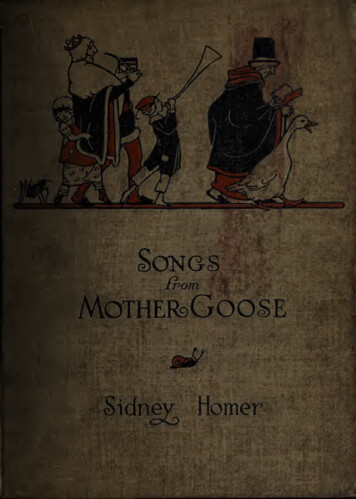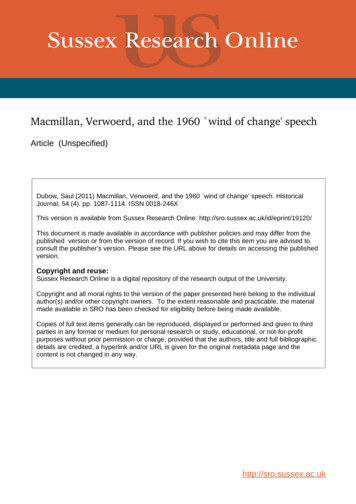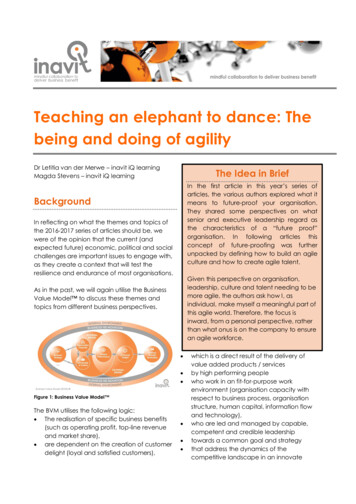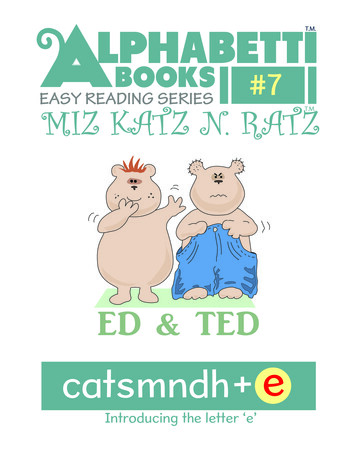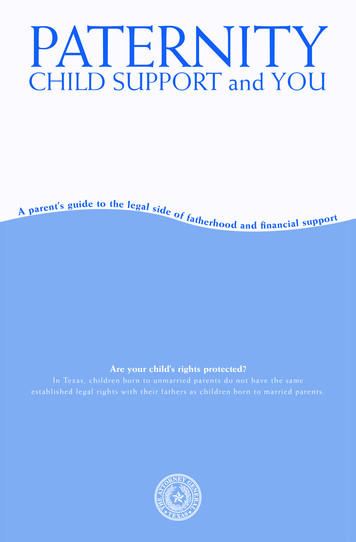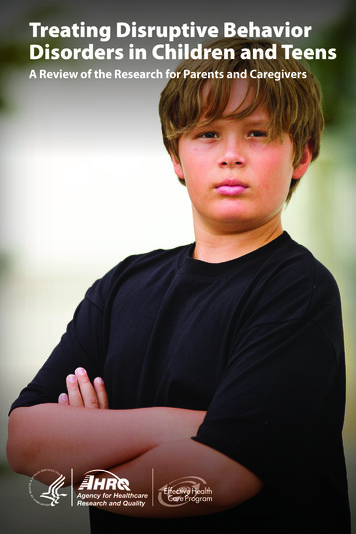
Transcription
The Elephant’s ChildThe Elephant’s ChildThe storyThis is an adaptation of a famous Rudyard Kipling story, which explains how the elephant got its trunk.The story is set in Africa, when the world was new and elephants did not have trunks.The elephant’s child lived with Father, Mother and Baby Elephant. He wanted to know all about theworld, and was always asking the other animals difficult questions. They usually told him to go away!One day, the elephant’s child asked a question that none of the animals wanted to answer. He askedwhat Crocodile had for his dinner. The animals were afraid of Crocodile. Parrot told the elephant’s childthat he must go to the green, green river and ask Crocodile himself.The elephant’s child set out on the long journey to the river. He took some melons to eat on the way.He met Python on his journey, but when he asked him about Crocodile, Python was afraid, andslithered away.At last the elephant’s child came to the green, green river where Crocodile lived. When the elephant’schild nervously asked Crocodile his question, Crocodile pretended not to hear clearly. He asked theelephant’s child to come closer. Then he grabbed the elephant’s child’s nose with his teeth!The elephant’s child squeaked loudly. Python, Parrot and Aunt Hippopotamus heard the noise andcame to help him. They pulled the elephant’s child in one direction, as Crocodile pulled in the other.The elephant’s child’s nose stretched as they pulled. It grew longer and longer, until Crocodile gave upand let go.Aunt Hippopotamus helped the elephant’s child soothe his sore nose. It stopped hurting, but it was stillvery long. The elephant’s child was unhappy with his new nose. He set off for home sadly.On his journey home, the elephant’s child discovered that having a long nose was actually very useful –he could flick flies away with it; pick grass with it; squirt mud with it; pick bananas with it; squirt waterwith it and sing with it!When the elephant’s child arrived home, Father, Mother and Baby Elephant thought his nose looked veryodd. So he showed them what he could do with it – he pulled Father’s tail, poked Mother and picked upBaby Elephant and threw him into a thorn bush! He made lots of trouble with his new nose.Eventually the family decided that something must be done. They went to see Crocodile. They promisedto pick bananas every day for him if he stretched their noses like he had the elephant’s child’s nose!Crocodile agreed.When the elephants got home, they all lived together peacefully. So now all elephants have long noses.1Explorers 3: The Elephant’s Child Teacher’s NotesThis page has been downloaded from www.macmillanenglish.com/young learners Macmillan Publishers Limited 2011 Text Louis Fidge 2006
The Elephant’s ChildIntroducing the booklThe coverExplain that the story is a classic (famous)tale (story) by Rudyard Kipling. Point to hisname. Explain that the story has beenadapted (made simpler) by another writer.Point to her name.The contents pagelHold up the cover. Read the book’s title toand with the class.lPoint to the elephant’s child. Ask What sort ofanimal is this? Elicit from the class anythingthey already know about elephants.llTalk about the picture. Ask the class todescribe the elephant. Ask Where is theelephant? (near a river in a jungle). Whatother animal can you see? (a crocodile).lAsk the children to turn to the contents page.Explain that the Contents list tells us what isin the book.lAsk How many chapters are there? Read thechapter titles to and with the class. Brieflyexplain any unfamiliar words (most will becovered in the chapter notes). Ask thechildren what page each chapter starts on.lPoint out that at the end of the book there isa poem (on page 42) and some facts aboutelephants (beginning on page 44).lDiscuss the pictures on the contents page.Ask What can you see?lAsk questions about each chapter title tostimulate the children’s interest, for example:Chapter 1: Show the cover again. Ask Who doyou think this is?Chapter 2: What animal do you think lives atthe river?Chapter 3: What do you think happens at theriver? etc.lTell the children to do the related activity onpage 1 of their Workbook.Ask What do you think the story is going to beabout?The title pagelAsk the children to turn to the title page.Hold up your own book and point to thepicture. Ask What is different about thiselephant? (It hasn’t got a trunk). Ask What doyou think the story is going to be about now?You can play the story on the audiocassette/CD at any time you choose.2Explorers 3: The Elephant’s Child Teacher’s NotesThis page has been downloaded from www.macmillanenglish.com/young learners Macmillan Publishers Limited 2011 Text Louis Fidge 2006
The Elephant’s ChildChapter 1The elephant’s childriverPages 3 to 6trunka homonym – it can also mean alarge chest or boxunclethe ‘le’ ending is very common:as in table, candle, applePassive worldBefore readinglPre-teach the active vocabulary (see theTeacher’s Notes Introduction page 13 and theGlossary). Use the notes in the table todiscuss any interesting features of the words.lAsk the children to do the activity onpage 2 of their Workbook to practise thenew vocabulary.lTell the children to look at the picture onpage 3. Read the Chapter 1 title again. AskWhich elephant do you think is Father Elephant?Which is Mother Elephant? Which is BabyElephant? Which one is the elephant’s child?Why do the elephants look strange?lTell the class to look at the picture on page 4.Ask What animal is the elephant’s child talkingto? (an ostrich). Ask the children to describethe ostrich. Discuss how both animals look:Are they happy, sad, angry?lAsk Where are the animals? (Africa). Talkabout what you can see in the background ofthe picture. Ask What other animal can yousee? What is it doing?lTell the children to look at the picture onpage 5. Ask What animal is the elephant’s childtalking to now? (a baboon). Ask the childrento describe the baboon. Ask What is thebaboon eating? (a melon). Does he look happy?How does the elephant’s child look? What otheranimal can you see in the background?Active vocabularyafraidpoint out the ‘ai’, as in rainauntpronounced like ‘aren’t’childthe ‘i’ here has a long sound– unlike its short sound in childrendinnerboth dinner and river (see below)have the common ‘er’ endingelephantthe ‘ph’ sounds like ‘f’, as it does inwords such as alphabet, photo andtelephonenewsome other ‘ew’ words include:dew, few, grew, stew, crew, threwand drew.questionthe letter ‘q’ is always followed by‘u’3Explorers 3: The Elephant’s Child Teacher’s NotesThis page has been downloaded from www.macmillanenglish.com/young learners Macmillan Publishers Limited 2011 Text Louis Fidge 2006
The Elephant’s ChildlTell the children to look at the picture onpage 6. Ask What animal is the elephant’s childtalking to now? (a parrot). Ask the class todescribe the parrot. Discuss how both animalslook: Are they happy? Sad? Point out that theparrot has one wing around the elephant’schild’s shoulders in a friendly manner.During readingllRead the chapter expressively to the class (orplay the audio cassette/CD). Do not stop toexplain anything or to ask questions. Ensurethe children are following in their books.6What did the elephant’s child ask AuntOstrich?7What did Aunt Ostrich say to him?8Who did the elephant’s child go to see next?9What did the elephant’s child ask UncleGiraffe?11 Who did the elephant’s child go to see afterUncle Giraffe?12 What did the elephant’s child ask AuntHippopotamus?Choose whichever of the following options ismost appropriate for your class:13 What did Aunt Hippopotamus say to him?14 Who did the elephant’s child go to see afterAunt Hippopotamus?15 What did the elephant’s child ask UncleBaboon?– Read the chapter again, a paragraph at atime, and ask the class (or individuals) toread each paragraph aloud after you.16 What did Uncle Baboon say to him?17 What did the elephant’s child want to knowabout Crocodile?– Do not read again yourself. Ask groups orindividuals to read the chapter aloud, aparagraph at a time.lWhat did the elephant’s child want to know?10 What did Uncle Giraffe say to him?– Read the chapter again and encourage theclass to read it with you.l518 All the animals wereCrocodile.Read (or play) the chapter again, aparagraph at a time. Explain the meaningand pronunciation of the words listed aspassive vocabulary, and any otherunfamiliar words.19 Why did the elephant’s child go to seeParrot?20 What did Parrot do with his beak?21 What did Parrot say to the elephant’s child?Discuss how the pictures can help the readerguess the meaning of the text.lAsk the children to find examples ofquestions and exclamations in the chapter.Draw attention to their punctuation. Readeach one aloud, and draw attention to howyour tone of voice changes.lPoint out how the animals’ names beginwith capital letters.lAsk the children to find and read aloudexamples of words containing: ‘ee’; ‘ea’; ‘oo’;‘ow’.Stage 1 comprehension (literal)Ask these questions orally, or set them asa written activity. You can also ask thechildren to do the activity on page 3 oftheir Workbook.1Where did the elephant’s child live?2Who did he live with?3Was the world new or old at this time?4Elephants did not haveof.4Explorers 3: The Elephant’s Child Teacher’s NotesThis page has been downloaded from www.macmillanenglish.com/young learners Macmillan Publishers Limited 2011 Text Louis Fidge 2006
The Elephant’s Childl13 Do you think the elephant’s child was afraidof Crocodile?Finally, ask individuals to re-read shortsections of the text aloud. Encourage them toread expressively and with appropriateintonation. (You might like to ask children toplay the role of particular characters andread their parts.)14 Do you think he was sensible to go and lookfor Crocodile?lWrite some words from the chapter on theboard and ask the children to find anysmaller words ‘hiding’ inside each longerword (for example, trunk.)lChoose a word from the text and brainstormas a class other words that rhyme with it.Write the rhyming words on the board anddiscuss which ones have the same letterpatterns and which don’t (for example, true:blue/glue; new/chew; too/zoo)lAsk the class what else they know about theanimals mentioned in the text. Ask Whatother animals might there be in Africa? Ask Areyou afraid of any animals? Why?lAsk the children to suggest other questionsthe elephant’s child might have asked eachanimal. Ask Do you think the elephant’s childwas rude to ask so many questions? Talk aboutwhy we ask questions. Discuss the fact that itis quite usual for young children to ask lotsof questions about the world. Ask Why do youthink this is?lThe animals were all fed up and impatientwith the elephant’s child. Discuss theimportance of being patient with youngchildren (such as younger siblings).lRemind the children that the story willexplain how elephants got their trunks. AskCan you guess how?10 Why do you think everyone was afraid ofCrocodile?lIf appropriate, try some Extension Activities(see the Teacher’s Notes Introduction page 19).11 Why do you think Aunt Ostrich said ‘Sshh!’to the elephant’s child?lAsk What do you think will happen next? Whodo you think the elephant’s child will meet on hisway to find Crocodile?After readingStage 2 comprehension (extension)Ask these questions orally, or set them as awritten activity for the more able. Answerswill vary. Encourage the children to givereasons for their suggestions, and accept anyanswer they can justify.1How do you know that the elephant’s childwas not the youngest child in the family?2Do you think elephants look strange withouttrunks?3Why do you think the elephant’s childwanted to know all about the world?4Which animal did the elephant’s child talk tofirst? Second? Last?5Was Aunt Ostrich cross with the elephant’schild? How do you know?6Why do you think she sent him to see UncleGiraffe?7How do you know that the elephant’s childhad asked the giraffe some questions before?8Who did the elephant’s child see beforeUncle Baboon?9Why do you think the elephant’s child askedUncle Baboon about melons?12 Why do you think Parrot tidied his featherswith his beak when the elephant’s childasked him about Crocodile?5Explorers 3: The Elephant’s Child Teacher’s NotesThis page has been downloaded from www.macmillanenglish.com/young learners Macmillan Publishers Limited 2011 Text Louis Fidge 2006
The Elephant’s ChildChapter 2At the riverrockthe two letters ‘ck’ make one soundtailwords with the ‘ai’ vowel digraphare quite common, and include:sail, rail, nail, snail, rain, train,brain, wait, paint, afraidtidythe ‘y’ is pronounced ‘ee’, as inbaby, lady, copy, empty etc.woodthe ‘oo’ here has a short sound, asin good, hood, cook and bookPages 7 to 10Passive vocabularycroakedcurled upflickedgroundlogmelon skinpythonslitheredBefore readinglPre-teach the active vocabulary (see theTeacher’s Notes Introduction page 13 and theGlossary). Use the notes in the table todiscuss any interesting features of the words.lAsk the children to do the activity onpage 4 of their Workbook to practisethe new vocabulary.lAsk the class to recall what happened in theprevious chapter.lRead the title of Chapter 2. Ask What do youthink the chapter is going to be about? Who doyou think lives at the river?lTell the children to look at the picture onpage 7. Ask Where do you think the elephant’schild is going? Point out that he is walking ona path. Ask How does he look? What has he gotwith him? (some melons) Why, do you think?(Draw attention to the melon skins on thepath which show he has been eating some ofthe melons.)Active vocabularyeyea palindrome (it is spelt the samebackwards and forwards); otherpalindromes include: bib, dad,mum, did, level, madam, noon,peep, popjourneythe ‘our’ sounds like ‘er’knowthe ‘k’ is a silent letter and is notpronounced; other similar wordsinclude: knee, knife, knock, knotlongthe two letters ‘ng’ make onesoundnearcontains the ‘hidden’ word earpolitea two syllable word (as are journeyand tidy)6Explorers 3: The Elephant’s Child Teacher’s NotesThis page has been downloaded from www.macmillanenglish.com/young learners Macmillan Publishers Limited 2011 Text Louis Fidge 2006
The Elephant’s ChildllTell the children to look at the picture onpages 8 and 9. Ask Who is the elephant’s childtalking to? (a snake). Introduce the word forthis particular type of snake: python. AskWhat do you think the elephant’s child is asking?Does he look afraid of the snake? Where is thesnake? (under a tree, near a rock) Askchildren to describe the python, and elicit thephrase ‘curled up’. Ask How long do you thinkthe snake’s body is?8What did he ask Python?9What did Python do to his tail?Tell the children to look at the picture onpage 10. Ask Who is the elephant’s child talkingto now? Does he look frightened? Is the crocodilecompletely awake? (Draw attention to the factthat he only has one eye open.) Ask the classto describe the crocodile. Ask What are theynear? (a river) What colour is it? Why do youthink the crocodile is on the river bank and not inthe water?14 What did the elephant’s child do when thelog opened one eye?10 What did the elephant’s child ask Pythonnext?11 What did Python do after he said ‘Sshh!’?12 Did Python tell the elephant’s child whatcrocodile had for his dinner?13 What did the elephant’s child do when hesaw a log on the river bank?15 What did the log of wood say when it openedits other eye?During readinglRead the chapter to and with the class.Follow the same procedure as you did forChapter 1 (see page 4) to help the childrenread and understand the text. Use the audiocassette/CD, if you wish.Stage 1 comprehension (literal)lAsk the children to find examples of animalsspeaking in the text. Draw attention to thespeech marks and discuss how they are used.Ask Which words go inside the speech marks?lAsk the children to find and read aloudexamples of verbs which end with ‘ed’ (thesuffix which indicates that the verb has a‘regular’ past tense).lAsk children to find examples of the wordvery in the text. Discuss how this modifies themeaning of the adjectives it precedes.lRead a selection of multi-syllabic words fromthe text and ask children to tap out thesyllables and say how many each wordcontains, for example, a–fraid (2);cro–co–dile (3).lFinally, ask individuals to re-read shortsections of the text aloud. Encourage them toread expressively and with appropriateintonation. (You might like to ask children toplay the role of particular characters andread their parts.)Ask these questions orally, or set them asa written activity. You can also ask thechildren to do the activity on page 5 oftheir Workbook.1Who did the elephant’s child say goodbye to?2Where was he going?3What did he take with him?4Was it a long or a short way to the river?5What did he eat on his journey?6Why didn’t he pick up the melon skins?7Who did the elephant’s child see under atree?7Explorers 3: The Elephant’s Child Teacher’s NotesThis page has been downloaded from www.macmillanenglish.com/young learners Macmillan Publishers Limited 2011 Text Louis Fidge 2006
The Elephant’s ChildAfter readinglWrite the word at on the board and ask thechildren to read it aloud. Now add ‘e’ to theend to make ate. Ask the class to read theword again. Discuss what difference the‘magic e’ makes to the pronunciation of the‘a’. Make some more magic ‘e’ words byadding ‘d’, ‘g’, ‘h’, ‘l’, and ’pl’ to thebeginning of ate.lWrite some common question words – who,what, when, why, where – on the board. Askthe class to make up questions of their ownusing these words, either about the text orthings in the classroom.lAsk Has anyone been on a long journey? Wheredid you go? Did you take anything with you toeat? Did anything interesting happen?lDiscuss ways in which different animalscamouflage themselves so they are hard tosee, like Crocodile in the story.lPoint out that we make the opposite of curled– uncurled – by adding the prefix ‘un’. Giveother examples, such as happy, tidy,comfortable, well, fair, pack, cover, do, or wrap.lDiscuss anything else the children knowabout parrots or crocodiles.10 Why do you think the elephant’s child didn’tknow the log of wood was a crocodile?lIf appropriate, try some Extension Activities(see the Teacher’s Notes Introduction page 19).11 How do you think the elephant’s child feltwhen the log of wood opened one eye?lAsk What do you think will happen next in thestory?Stage 2 comprehension (extension)Ask these questions orally, or set them as awritten activity for the more able. Answerswill vary. Encourage the children to givereasons for their suggestions, and accept anyanswer they can justify.1How do you think the elephant’s child feltwhen he said goodbye to his family?2Do you think it was a good idea to take somemelons? Why?3How do you know the elephant’s child didn’tlike to leave his melon skins on the ground?4Why do you think snakes curl up?5How do you know the elephant’s child waspolite?6Why do you think Python did not answer theelephant’s child’s questions?7Why do you think Python flicked his tail?8Why do you think Python slithered under arock?9Why do you think the elephant’s child satdown on the log of wood?12 How did Crocodile speak?lWrite some irregular past tenses from thetext on the board, such as ate, said, was, took,left, saw, went, came, sat. Ask the children tofind and read a sentence from the text whichcontains each verb and discuss its meaning.8Explorers 3: The Elephant’s Child Teacher’s NotesThis page has been downloaded from www.macmillanenglish.com/young learners Macmillan Publishers Limited 2011 Text Louis Fidge 2006
The Elephant’s ChildChapter 3Dinner time!Pages 11 to 14mouthother words with the common ‘ou’vowel digraph include: out, shout,cloud, loud, sound, round, found,count, mouse, housenext tomany prepositions are single words– on, under, etc. – but thispreposition is made of two wordsnosenote the difference in thepronunciation of close and nosesharpcontains the common ‘ar’ soundteethwe must put the tongue betweenour teeth to say the ‘th’ at the endof ‘teeth’!wantthe ‘a’ sound likes ‘o’Passive vocabularysnapsqueakedBefore readingActive vocabularyclosergrabbedwhen we make the comparativeform of an adjective ending with aconsonant ‘e’ (like close, brave,safe, wide, cute etc.) we take offthe ‘e’ before adding the ‘er’ suffixwhen we add ‘ed’ to a short singlesyllable word which ends with ashort vowel consonant, wedouble the final consonant of theword: grab – grabbedOther examples are: rob/robbed;hop/hopped; beg/beggedlPre-teach the active vocabulary (see theTeacher’s Notes Introduction page 13 and theGlossary). Use the notes in the table todiscuss any interesting features of the words.lAsk the children to do the activity onpage 6 of their Workbook to practise thenew vocabulary.lAsk the class to recall what happened in theprevious chapter.lRead the title of Chapter 3. Ask What do youthink the chapter is going to be about?lTell the children to look at the picture onpage 11. Discuss the expression onCrocodile’s face. Ask Why do you think he hasgot his mouth open? What are his teeth like?How many can you see?lTell the children to look at the picture onpages 12 and 13. Ask How does the elephant’schild look? What do you think Crocodile mightbe saying to the elephant’s child? (He is askinghim to come closer.) Is he being friendly, or is itfor another reason? Does Crocodile look friendly?Will the elephant’s child go closer?9Explorers 3: The Elephant’s Child Teacher’s NotesThis page has been downloaded from www.macmillanenglish.com/young learners Macmillan Publishers Limited 2011 Text Louis Fidge 2006
The Elephant’s ChildlTell the children to look at the picture onpage 14. Ask What is happening? What part ofthe elephant’s child’s face has Crocodilegrabbed? Why? How does the elephant look?What do you think he will do?lAsk the children to find some full stops in thetext. Discuss their purpose. Remind childrenthat they are like red traffic lights – they tellyou to stop! Read a few sentences again todemonstrate. Discuss what other punctuationmarks may be used to end a sentence(question or exclamation marks).lPoint out how the word You on page 11 is inbold print. Read the whole sentence in whichit appears to demonstrate how to emphasisethe word when you read it. Also point outhow the writer uses Wh-what on page 12 tosuggest that the elephant stutters when he isafraid.lDraw attention to any contractions used inthe text, such as isn’t, can’t. Read thesentences in which they appear to make surethe children understand how they are used,and what they mean.lAsk children to find and read any words thatcontain double consonants, such as dinner,still, and little.lFinally, ask individuals to re-read shortsections of the text aloud. Encourage them toread expressively and with appropriateintonation. (You might like to ask children toplay the role of particular characters andread their parts.)During readinglRead the chapter to and with the class.Follow the same procedure as you did forChapter 1 (see page 4) to help the childrenread and understand the text. Use the audiocassette/CD, if you wish.Stage 1 comprehension (literal)Ask these questions orally, or set them asa written activity. You can also ask thechildren to do the activity on page 7 oftheir Workbook.1Crocodile opened his mouth and.2What were Crocodile’s teeth like?3Was the elephant’s child afraid of Crocodile?4Did the elephant’s child run away?5What did the elephant’s child want to knowabout Crocodile?6What did Crocodile do when the elephant’schild asked him what he ate for dinner?7Why did Crocodile tell the elephant’s child tocome closer?8How many times did Crocodile ask theelephant’s child to come closer?9Did the elephant’s child go closer toCrocodile?After readingStage 2 comprehension (extension)11 What did Crocodile grab?Ask these questions orally, or set them as awritten activity for the more able. Answerswill vary. Encourage the children to givereasons for their suggestions, and accept anyanswer they can justify.12 What did the elephant’s child squeak?113 What did the crocodile do when theelephant’s child squeaked?Why do you think Crocodile laughed in thefirst sentence?2What made the elephant’s child afraid ofCrocodile?10 What did Crocodile say he was going to havefor his dinner today?10Explorers 3: The Elephant’s Child Teacher’s NotesThis page has been downloaded from www.macmillanenglish.com/young learners Macmillan Publishers Limited 2011 Text Louis Fidge 2006
The Elephant’s Child3The elephant’s child did not run away whenhe saw Crocodile’s sharp teeth. Do you thinkhe was brave or silly?4Which expression tells you that theelephant’s child was pleased to seeCrocodile?5What words on page 11 tell you thatthe elephant’s child has been looking forCrocodile for a long time?6Which words on page 11 show that theelephant’s child was very polite?7Why do you think Crocodile laughed whenthe elephant’s child asked him what he hadfor dinner?8Why do you think Crocodile really asked theelephant’s child to come closer?9Why did Crocodile call the elephant’s child‘little one’?lAsk the class what gesture Crocodile mighthave used when he said ‘Come here.’(Beckon with your finger.) Do some otherhand gestures and ask the class what theymean, for example be quiet; sit down; standup; stop; hello; open your book etc.lIf appropriate, try some Extension Activities(see the Teacher’s Notes Introduction page 19).lAsk What do you think will happen next in thestory?10 Why did Crocodile grab the elephant’s child’snose?11 How do you think the elephant’s child feltwhen Crocodile grabbed his nose?lFind and read the two imperatives in thetext: ‘Come closer’ and ‘Let go!’. Discuss thecontext in which they occur. Use someimperatives in the classroom and get thechildren to respond appropriately, forexample Stand up. Sit down. Take out yourbooks. Shut the door. etc.lDemonstrate the meaning of the prepositionsnext to and between with classroom objects.lWrite the word head on the board and read italoud. Alter the spelling to make some newwords, and ask the class to read each one:add ‘r’ after the ‘a’ (heard); rub out the ‘d’(hear); rub out the ‘a’ (her); add ‘e’ to the end(here); add ‘w’ to the beginning (where) etc.11Explorers 3: The Elephant’s Child Teacher’s NotesThis page has been downloaded from www.macmillanenglish.com/young learners Macmillan Publishers Limited 2011 Text Louis Fidge 2006
The Elephant’s ChildChapter 4Python comes to helpswimmingwe double the final consonant inswim when we add the suffix ‘ing’to make swimmingthickthick and its opposite thin bothbegin with the consonant digraph‘th’Pages 15 to 18Passive vocabularyone wayslipBefore readinglPre-teach the active vocabulary (see theTeacher’s Notes Introduction page 13 and theGlossary). Use the notes in the table todiscuss any interesting features of the words.lAsk the children to do the activity onpage 8 of their Workbook to practise thenew vocabulary.lAsk the class to recall what happened in theprevious chapter.lRead the title of Chapter 4. Ask What do youthink this chapter is going to be about?lTell the class to look at the picture onpage 15. Ask Why do you think Python hascome out from under the rock? How does helook? Where do you think he’s going?lTell the children to look at the picture onpages 16 and 17. Ask Where is Crocodile?What is he doing? What is happening to theelephant’s nose? Who are helping the elephant’schild? How are they helping? Will Crocodile pullthe elephant’s child into the river?lTell the children to look at the picture onpage 18. Ask What has happened? HasCrocodile let go? What is the elephant’s child’snose like now?Active vocabularybankhardheardnote the difference in the way hearand heard are pronounced, despitethe similar spelling patternmudnoisehave fun saying the following: anoisy noise annoys the boyspullnote the sound of the ‘u’: othersimilar words include put, push,bush, bull, fullstretchedhere the ‘ed’ ending sounds like ‘t’12Explorers 3: The Elephant’s Child Teacher’s NotesThis page has been downloaded from www.macmillanenglish.com/young learners Macmillan Publishers Limited 2011 Text Louis Fidge 2006
The Elephant’s ChildDuring readinglRead the chapter to and with the class.Follow the same procedure as you did forChapter 1 (see page 4) to help the childrenread and understand the text. Use the audiocassette/CD, if you wish.lTell the children to find examples ofexclamation marks in the text. Read thesentences in which they appear and talkabout when we use them.lAsk the children why they think the words-t-r-e-t-c-h-e-d is shown as it is.lAsk the children why they think the fourthPlop! on page 18 is in bold print. (It refers toAunt Hippopotamus, who is much heavierthan the other animals.)lTell the children to find words that arerepeated a lot in the chapter, such as pulledor and. Ask them to find as many of each asthey can.lAsk the children to find and read any verbswhich show movement, such as slithered,pulled, stretched, slip, curled, flew, swimming,ran, slid, grabbed, opened, fell.lFinally, ask individuals to re-read shortsections of the text aloud. Encourage them toread expressively and with appropriateintonation. (You might like to ask children toplay the role of particular characters andread their parts.)Stage 1 comprehension (literal)Ask these questions orally, or set them asa written activity. You can also ask thechildren to do the activity on page 9 oftheir Workbook.1Who heard the noise?2He slithered out from under his.3What did Python want to do?4What did Python tell the elephant’s child todo?5What did Crocodile do when the elephant’schild pulled harder?6What happened to the elephant’s child’snose as they pulled?7What happened to the elephant’s child’s feetin the mud?8What did Python curl round?9Who came to help next? Why?After readingStage 2 co
The Elephant’s Child Introducing the book The cover l Hold up the cover. Read the book’s title to and with the class. l Point to the elephant’s child. Ask What sort of animal is this? Elicit from the class anything they already know ab


